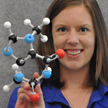Related Questions
- Renee how do you find the DNA of a baby when someone is pregnant
- what's the most exciting thing about working with DNA?
- does every living thing have DNA :)
- What are degraded sources of DNA? And how will the new methods work in identifying the DNA?
- I know DNA stands for Deoxyribonucleic acid but what exactly is DNA and what is its main purpose?









This is a very valid point – the crime books don’t ever detail all the very strict protocols that have to be followed when it comes to handling DNA samples and stopping contamination (it wouldn’t make for a very exciting plot!). Our bodies are constantly sweating and shedding cells that contain DNA and this can cause contamination. We need to stop these cells on your hands being transferred onto things in the laboratory. In a lab, we usually wear gloves to stop the chemicals we use from harming us – but in the case of DNA, it is almost the other way around – we are the “harmful” part, as our DNA can contaminate the samples, equipment and chemicals we use! So gloves do have a very important role to play in stopping the transfer of contaminating DNA.
The ways we stop DNA contamination not only lie in simply putting on a pair of gloves, but also the technique you use. The gloves can be clean, but like you say, if you put your hands all over them when you put them on may mean they might not be so clean! When we put gloves on in the lab, we only touch the very edge where you hand goes in and try to avoid touching the finger areas that come in contact with samples. And you have to be very conscious of what you are doing – for example if you get an itchy nose, you can’t just scratch it because the act of touching your face could transfer DNA onto your gloves. And we never wear the one pair of gloves all day – I regularly change mine. And for extra precaution we use lots and lots of bleach, ethanol and detergent as these will destroy cells and DNA – once my gloves are on, I wipe my hands with bleach to destroy any DNAthat may be on the gloves. We also use UV light in our labs to destroy any stray DNA on equipment, racks and surfaces. Preventing contamination is very involved process – we even have steps in our DNA analysis that can be used as checks for contamination. Since DNA profiling began, protocols both out at the crime scene and in the laboratory have really had to become very strict in order to prevent DNA evidence becoming contaminated with either the police or scientist’s DNA and the process of ensuring evidence doesn’t become contaminated is one that is always improving and ongoing.
0